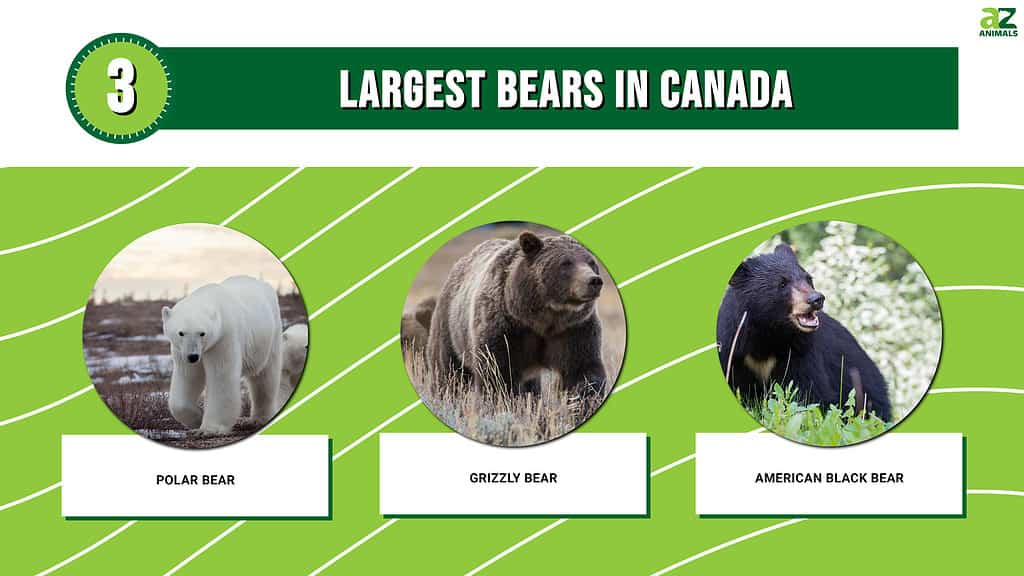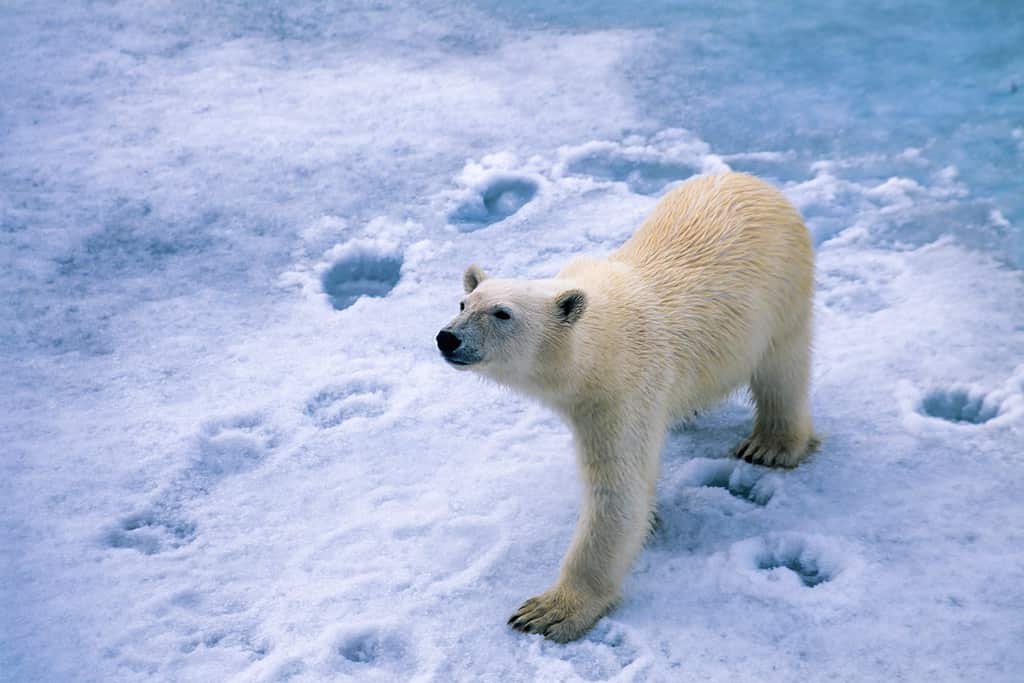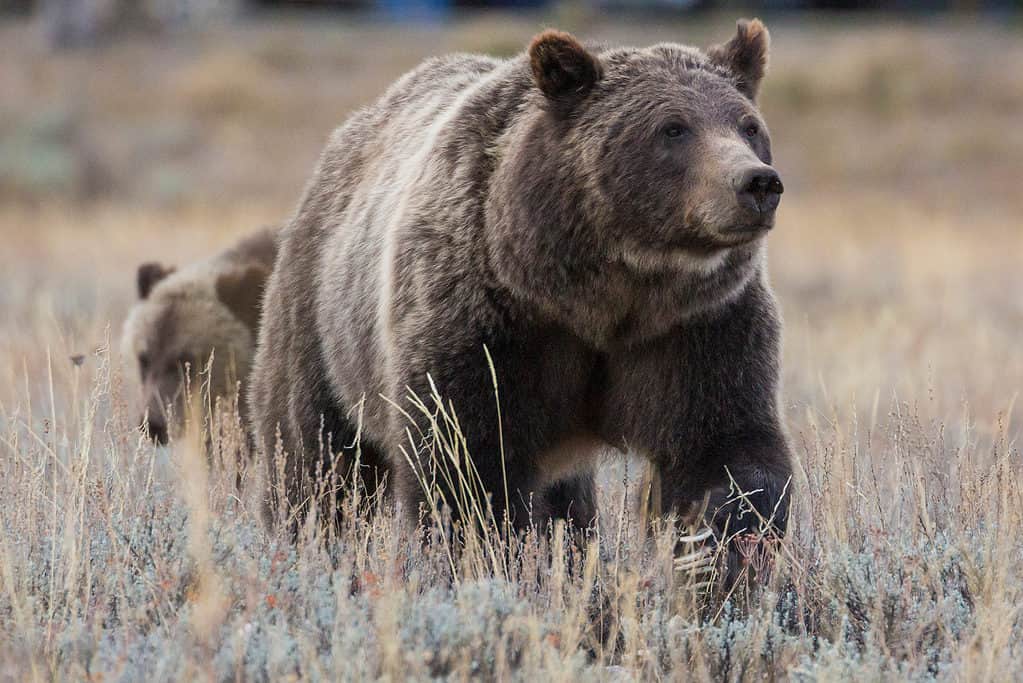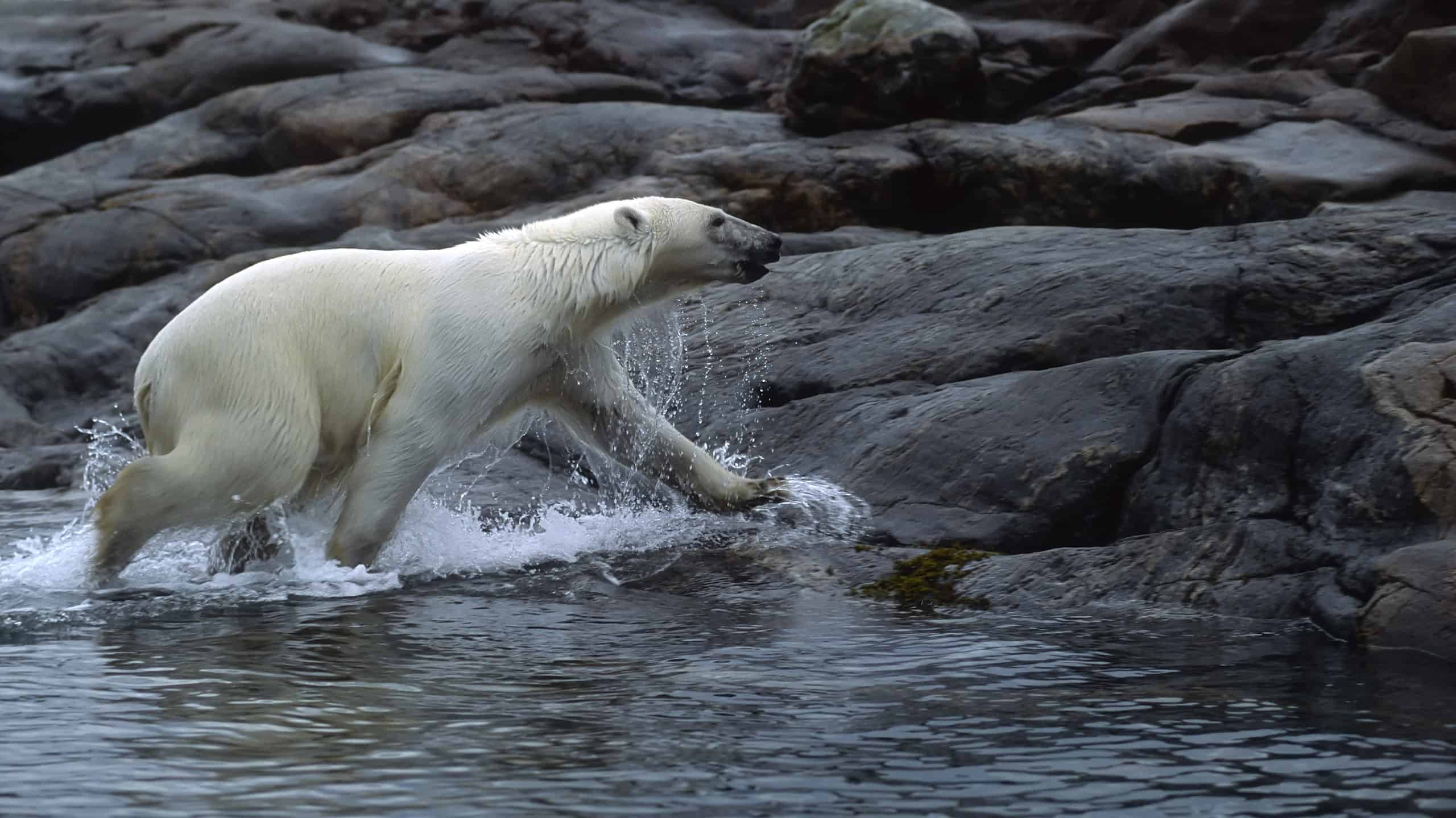Bears are some of the largest and most efficient predators on Earth. The three largest types of bears in Canada range from about 600 to 2,000 pounds. That’s huge! Of course, the size of these bears can vary widely, depending on the season, food availability, and even where they happen to live. Read on to learn about the largest bears in Canada.

Polar Bear

Polar bears are by far the largest bears in Canada, weighing up to 2,000 pounds.
©Lasse Johansson/Shutterstock.com
The polar bear, Ursus maritimus, is the largest of the bears in Canada and throughout the world. The World Wildlife Fund Canada estimates the current population of polar bears worldwide between 22,000 and 31,000. The IUCN Red List of Threatened Species lists the polar bear as a vulnerable species. Approximately two-thirds of the polar bears that exist today live in Canada. However, their suitable habitat, on the coasts and polar ice, has diminished due to warming temperatures. This loss of habitat will affect the chances of survival for the polar bear in the years to come.
Appearance
Polar bears have black skin covered with white fur. Their heads are relatively narrow, as compared with most other bears. Their thick fur even insulates their paw pads, helping to protect their feet. They have long claws and slightly webbed paws. Their black noses contrast with their white fur and the ice.
Size
Male polar bears weigh up to 800 kg, or roughly 1,760 pounds. They can grow as big as 3 meters in length, or nearly 10 feet. Female polar bears weigh around half that, up to 400 kg, or about 880 pounds. They grow up to 2.5 meters, or a little more than 8 feet in length. The largest polar bears recorded have exceeded 2,000 pounds.
Diet
Polar bears have a mostly carnivorous diet. They eat primarily seals. They also eat walruses, small whales, caribou, fish, sea birds, eggs, rodents, and even garbage. Polar bears also sometimes consume plant matter, such as kelp or berries.
Where to Find Polar Bears in Canada
Polar bears in Canada live in the ice-covered regions in the far north. They depend on the sea ice for survival and only leave for the shore for short periods when the ice melts. Their range extends from as far west as the Yukon and the Beaufort Sea to Newfoundland and Labrador in the east. Their southernmost Canadian range extends around the perimeter of Hudson Bay and James Bay.
Churchill, Manitoba, on Hudson Bay, is known as the Polar Bear Capital of the World. Every fall, polar bears migrate through the region from October through November, as ice forms on the bay. In 2023, researchers announced that the polar bear population migrating through the Churchill area has decreased by 27 percent over the last five years. They say this data correlates to a 10 percent decline in winter ice, and also to a decrease in the average weights of the bears. None of this is good news for Canada’s polar bears.
Grizzly Bear

Grizzly bears, a subspecies of brown bears, have broad heads and light-tipped fur.
©BlueBarronPhoto/Shutterstock.com
The next largest bear in Canada is the grizzly bear, Ursus arctos horribilis, a North American subspecies of the brown bear. The World Wildlife Fund Canada estimates the population of grizzly bears in Canada to equal about 26,000 individuals. More grizzly bears live in Alaska than in all of Canada. Habitat degradation and fragmentation have forced grizzly bears in Canada farther to the west and north. Conservationists estimate that grizzlies today inhabit only about half of their original range.
Appearance
Grizzly bears typically have brown fur with legs darker than the rest of their bodies. Their light-tipped or grizzled fur, however, can range in color from blond to black. Grizzly bears have broad, round faces that appear a bit concave, or dished. Their ears are small and round. They have a large hump on their shoulders comprised of thick muscle that they use to power their mighty front legs.
Size
Grizzly bears range in length from around 2 to 2.4 meters, or about 6.5 to nearly 8 feet. They have average weights that span about 90 kg, or roughly 200 pounds, to about 360 kg, or approximately 800 pounds. Males average about 10 percent larger than females. The weight of a grizzly bear depends largely on the season and where they live. These bears tend to pack on a lot of weight in the fall, and they emerge quite skinny in the spring. The grizzly bears that live in Canada tend to be smaller than those that reside in Alaska.
Diet
Grizzly bears have an omnivorous diet. They eat plenty of different types of plants, including berries and other fruits, grasses, roots, and more. They also eat lots of different prey, from large animals like moose, elk, caribou, and deer, to small mammals like rodents. You have probably seen pictures and videos of grizzly bears catching and eating fish in rivers and streams. They will also eat carrion and human garbage.
Where to Find Grizzly Bears in Canada
More than half of the roughly 26,000 grizzly bears in Canada live in British Columbia. The rest reside in the western part of Alberta, Yukon, the Northwest Territories, Nunavut, and far northern Manitoba. Grizzly bears spend most of the summer in the meadows and valleys of the lowlands. They sometimes forage in the forests, especially when berries ripen, and they spend time near streams. In the winter, they begin to move to higher elevations where they will enter a state of torpor, akin to mild hibernation. This period may last six months or longer.
American Black Bear

American black bears are the most numerous of the Canadian bears by far.
©Ghost Bear/Shutterstock.com
The third largest of the bears in Canada is the American black bear, Ursus americanus. This species is the most widespread and numerous of the Canadian bears. Conservationists estimate the population of American black bears in Canada at around 380,000. Habitat fragmentation and the encroachment of human developments and activities have taken a toll on American black bears across North America. They now occupy approximately 60 percent of their original range.
Appearance
American black bears often appear with fully black coats of fur, but they can also be dark to light brown, have tints of red or blue, or even creamy white. These bears have larger and more pointed ears than grizzly bears. They have small eyes and pointed faces, often with lighter-colored muzzles. They have strong paws with long claws, and their tail is very short. These bears also lack the large hump on the shoulders that grizzly bears have.
Size
The size of American black bears varies widely based on food availability and location. These bears average about 2 meters or about 6.5 feet. Like other bears, the American black bear exhibits sexual dimorphism. Males of this species are considerably larger than females. Males can reach about 275 kg, or around 600 pounds in weight. Meanwhile, females usually reach only about 90 kg or around 200 pounds.
Diet
American black bears have an omnivorous diet. They eat a very wide variety of foods, from berries, fruits, flowers, grasses, and other vegetation to insects, birds, eggs, fish, small mammals, or just about any other prey that suits them. Because humans have come to live in close proximity to American black bears, these animals have become adept scavengers, rooting out garbage and snatching food from crops, chicken houses, and livestock pens.
Where to Find American Black Bears in Canada
American black bears live in every territory and province in Canada except for Prince Edward Island. They live mainly in forested areas of all sorts, but also in the mountains and in swamps. They retreat to dens for most of the winter where they spend their time in torpor. American black bears maintain a presence in several of Canada’s national parks, including Banff National Park, Jasper National Park, Yoho National Park, and Kootenay National Park.
The Haida Gwaii archipelago, off the coast of British Columbia, is home to the largest American black bears in the world. This subspecies, Ursus americanus carlottae, has completely black fur and feature prominently in the culture of the indigenous Haida people.
Another subspecies, the Kermode bear, Ursus americanus kermodei, resides mainly along the coastal regions of northern and central British Columbia. This subspecies of the American black bear carries a recessive gene that can produce a nearly white bear when both parents carry a copy of the gene. White Kermode bears are called “spirit bears” and only about 100 to 500 are estimated to exist.
Thank you for reading! Have some feedback for us? Contact the AZ Animals editorial team.








